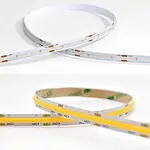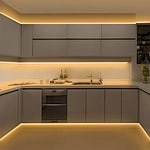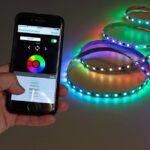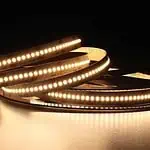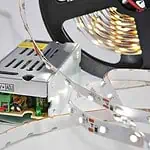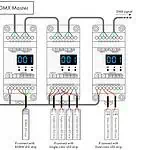Doing tasks in dimmed lighting causes eye tension and headaches. That is why adequate brightness is essential. However, the bitter truth is that LED strips often lose their brightness for several reasons. So, how can you make them brighter?
The brightness of the LED strips greatly depends on the voltage and current flow rate. Increasing the voltage (to a certain extent) can make the LED strips brighter. Besides, LED density, color temperature, humidity, LED quality, etc., affect the LED strip’s brightness. The easiest way to control the intensity of the LED strip is to use an LED controller. But there is much more to consider.
In this article, I have added 16 ways to make your LED strip lights brighter. But before that, let’s first explore the reasons for LED strips losing their brightness-
Why Does LED Strip Losing Brightness?
LED strip lights are well known for their continuous light output. But it can start losing brightness for different reasons. These are as follows-
LED Density
The density of the LED strip refers to the number of LEDs per meter. So, the higher the LED strip, the brighter the light will appear. If you purchase a low-density LED strip, it will not glow as bright as the one with more LEDs.
Color Temperature
The color of the LED strip also impacts the brightness of the light. With the same lumen ranting, a cool light may appear brighter than a warm light. That is why you must consider the color of the LED strips before application. Warm lights have a low color temperature, giving a dim and cozy ambiance. But cool lights appear brighter due to their high-temperature bullish light rays. To know more about color temperature, check this- How to Choose LED Strip Color Temperature?
Heat
Though the LED strip doesn’t produce much heat compared to other forms of lighting, it can impact the brightness. For many reasons, LED lights can get overheated, which makes them dim. Besides, the outer casing or transparent covering of the strips can get yellowish due to heat. This makes the light appear less bright.
Humidity
Moisture is another no-no for LED strip lights. Accumulation of moisture in the LED strips corrodes or rusts the internal components. This can reduce the brightness of lights over time. This type of situation is common when you install LED strips in a highly humid area. In this case, a waterproof LED strip with complete sealing is essential.
Strip Length
When extending the LED strip length, voltage drop becomes a major issue. As you join multiple LED strips to increase its length, the brightness of the LEDs gradually reduces. So, the LEDs closer to the power source seem brighter, and it dims gradually as the length is extended. To understand this better, check this article- What is LED strip voltage drop?
Design Quality
All LED strips don’t give you the same quality. Due to poor design and low-quality LEDs, your strip lights may lose their brightness. Two LED strips of different brands with the same lumen ratings don’t give the same brightness. Many brands use low-quality LEDs that don’t provide illumination as the packaging specifies. Always purchase LED strips from reliable manufacturers who provide well-binned LEDs to avoid such a situation.
Strip Placement
The location or the placement of the LED strips also depends on how bright the lighting will appear. For instance, if you have a room with a high ceiling, the brightness of LED strips alone can’t provide adequate ambient lighting. Besides, the availability of light, room color, etc., also affect the lighting outcome or the appearance of light output.
Exposure to Elements
Installing the same LED strip indoors and outdoors will not give the same brightness. If a light seems dimmed outdoors, it may appear too bright for indoor application. Here, the surrounding lighting and area of the space also matter. Besides, in outdoor lighting, LED strips can face dust accumulation issues. This makes the LED strips lose their brightness.
Power Source
LED strips will get dimmed if the power source is not strong enough. You must ensure proper current flow and voltage supply to ensure the LED lights glow with adequate brightness. However, a loose wire connection can dim the lighting.
Aged Stripes
Using LED strips for a long time makes the LEDs dim, which is a natural phenomenon. The brightness from a new fixture will not be the same after years of use. So, as the LED strip ages, its brightness starts to dim.
16 Ways to Make LED Strip Lights Brighter
Now, you know the reasons why LED strips get dimmed. But how do we make them brighter? Here, I am adding 17 ways in which you can increase the brightness of your LED strip-
1. Select High Luminous LED Strips
The lumen rating of the bulb determines the intensity of light output. Purchasing LED strips with higher lumen value will provide brighter light output. So, if your current LED light is 440 lumen and you find it dimmed, purchase one with a greater rating. However, don’t install something too bright that discomforts your eyes. Here, I am adding some suitable lumen ratings for different locations-
| Area | Recommended Lumen Ratings |
| Kitchen | 1000 – 1600 lumen |
| Dining Room | 440 – 800 lumen |
| Living Room | 230 – 440 lumen |
| Bedroom | 230 or 270-lumen |
| Home Office | 800-1000 lumen |
| Bathroom | 330 – 400 lumen |
| Workspace | 8,000 – 10,000 lumens |
To learn more, check this- Lumen to Watts: The Complete Guide.
2. Increase The LED Density
LED density indicates the number of LEDs per meter. LED strip lights are rope-like fixtures measured in meters. They are available in different densities; for example- 60LEDs, 120LEDs, 180LEDs, and 240LEDs per meter. As you increase the number of LEDs, the fixture’s brightness increases. High-density LED strips not only give brighter lighting but also give a seamless finish. You will see a dot-like effect by installing low-density strips, but by increasing the density, you will no longer face such issues. Besides the size of the LED chip, SMD also impacts the strip’s brightness. For instance, SMD5050 gives out more brightness than SMD3528. To know more, check this article- Numbers and LEDs: What Does 2835, 3528, and 5050 Mean?
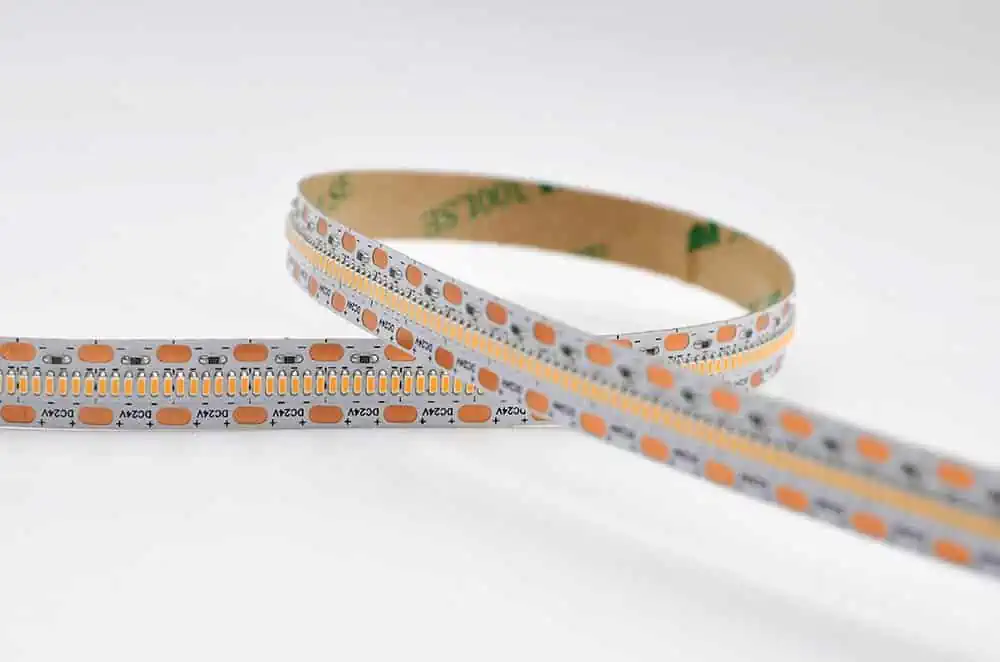
3. Mount LED Strips On Reflective Surface
Another way to make your LED strip brighter is by mounting them on a reflective surface. You can use aluminum foil, whiteboard, or even mirrors for this task. As the light from the LED strip hits the surface, it reflects back, making the lighting output brighter. When you install lights on a plane wall, much of the light gets absorbed. As a result, the lights seem dim. In this case, aluminum foil is the cheapest way to create a reflective medium. You can simply tape the foils on the installation area. However, for the best result, try installing mirrors. For different LED strip mounting techniques, this article will help you- Installing LED Flex Strips: Mounting Techniques.
4. Strengthen Your Power Supply
If your power source is not providing sufficient energy to the strips, the fixtures will not provide enough brightness. Besides, you will also face issues like light flickering. LED strips use versatile power sources. It can be a regular plugin or USB/battery-powered LED strips. Besides, connecting these to solar panels also works. If you are not satisfied with the power supply, try strengthening it to get a better lighting outcome. For this, check if the power source fulfills the current and voltage requirements of the LED strips. You should also keep the wirings accurate and avoid overloading. To know different ways of powering LED strips, check this out: How To Use LED Strip Lights Without Plug?
5. Use A Brightness Controller
An LED controller allows you to adjust the brightness of the fixture. Different types of controllers are available for LED strips: IR, RF, 0/1-10V, DALI RGB, DMX LED Controller, etc. Besides, Wi-Fi and Bluetooth-enabled LED strips are also available. You can choose the controller that suits your application and strip lights best. This will not only help you to control the brightness but also allow you to change light color, lighting pattern, and more. What is more impressive is that you can connect the LED strips to your phone and control lighting from anywhere. Check this article to get a complete guideline on LED controller- LED Controller: A Comprehensive Guide.
6. Opt for High-Quality LED Strips
The quality of LED strips matters to get the appropriate brightness. There are numerous brands in the market, but all of them don’t give the same lighting output. Cheap branded LED strips use low-quality LED chips that impact the brightness of the light. Besides, the intensity of the lights doesn’t match the ratings of the packaging. To avoid such a situation, always purchase LED strips from reputable brands. If you are planning for large lighting projects, China is your best option to import high-quality LED strips. Click on this link to learn – How To Import LED Lights From China.
However, before purchasing any LED strips, check out whether it has the essential certifications. This will ensure your purchased fixture is of high quality. Now, what certifications should a high-quality LED strip have? Check this article for your answer- The Certification of LED Strip Lights.
7. Use A Heatsink
LED strips get overheated for several reasons, which may affect the brightness of the light. This can also cause permanent damage to the LED strip. To avoid such situations, using a heatsink is essential. LED lights generate heat while operating. Using a heatsink removes the emitted heat from the LED chip, keeping the circuit cool. Thus, it prevents the fixture from overheating without hampering its brightness. To learn more, check this guide- LED Heat Sink: What Is It and Why It’s Important?
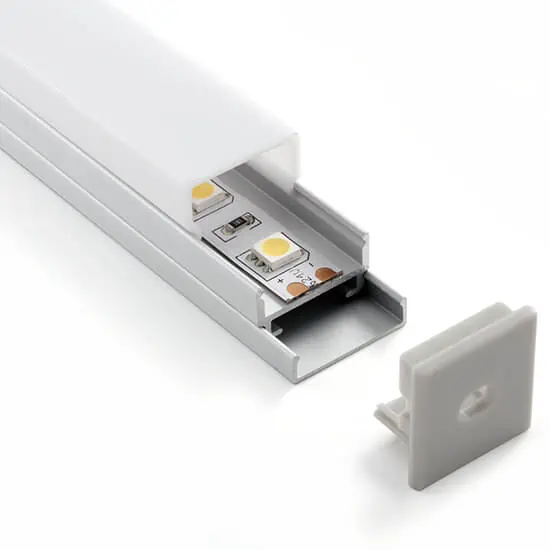
8. Select Bright White Fixtures
If you use yellow, orange, or any warm lighting, your room may look dull. For this, I suggest you use bright white lights. You can choose cool lighting ranging from 4000K to 6500K. This range of color temperature provides a bluish tone that looks much brighter than warm tones. Bright white lights with a cool tone are excellent for task lighting. This produces enough light intensity to keep your focus on track.
9. Pay Attention to the Beam Angle
Do you know the angle of the lighting can affect its brightness? When you use a wider beam angle LED strip, it spreads the light throughout a large area. As a result, the intensity of the light is divided, and the light doesn’t seem very bright. Having the same lumen rating, an LED strip with a narrow beam angle looks brighter. In this case, the light is not diffused; it is instead concentrated in a specific direction. This makes the light look more bright. To know details about beam angle, check this article- Everything You Need To Know About Beam Angle.
10. Use Multiple Strips
The easiest solution to increase the brightness of your LED strip light is to use multiple strips. If you find strengthening the power supply or implementing other processes difficult, simply go for this idea. Install multiple LED strips side by side to create a more intense light output. You need not purchase a high-lumen rated fixture using this technique. Besides, this also provides an even light throughout the ceiling. Following this article, you can mount multiple LED strips to the ceiling- How To Install LED Strip Lights on the Ceiling?
11. Use A Diffuser
Many times, too much brightness can be uncomfortable for your eyes. To get rid of this problem, use a diffuser. Now, what is a diffuser? It is a covering or lid of the LED strip that brings out a softer light output. These diffusers can be of many types- transparent, frosted, or milky white. Using these, you will get clean and soft lighting, keeping the brightness intact.
12. Increase the Distance Between the Surface and the Fixture
If you install the LED strips too close to the surface, the fixture will not get enough space to spread its brightness. So, you must keep sufficient space between the installation surface and the LED strips. This will provide sufficient space for the light to glow properly with proper light distribution.
13. Check Voltage Dropage
LED strips are voltage-sensitive. If the voltage following the LED strip is not sufficient, it directly impacts the brightness. For example- if you have a 24V LED strip light, powering it with 12V will not provide enough brightness. Increasing the voltage will make the lighting more intense. Besides, increasing the length of the LED strips also shows voltage-dropping issues. So, you must ensure the voltage flow fulfills the requirement of the LED strip.
14. Keep The Fixtures Clean
Dust and dirt accumulation on the LED strip makes the fixture dirty. Especially when you install LED strip lights in an oily or moist environment, it makes the fixtures more dirty. This covers the LEDs and creates a dirt layer, dimming the lighting output. As a result, your LED lights don’t look as bright as before. So, you must clean the lights regularly. Use a dry cloth; if it’s too dirty, you can wet it a bit. But make sure the power is off. Don’t turn the fixture off until it dries completely. However, the IP rating of the lights also matters. If you wet clean the LED strips, it can get damaged if it has low IP ratings. For more, check this- IP Rating: The Definitive Guide.
15. Replace Faulty LEDs
LED strips combine numerous LED chips to bring uniform lighting. If any of the LEDs is defective, it hampers the entire lighting output. You may face issues like light flickering or sudden shutdown. In this case, detect the faulty LEDs and replace them with a new one.
16. Inspect Wiring for Issues
If you find sudden dimming of your LED strips, check if the plug is connected properly. You must also check other wiring to ensure proper current flow. Turn off the light and inspect the wiring. Once you have fixed it, power the light up. If there is any wiring issue, your LED strips will glow brighter after fixing the wiring.
LED Lights Get Brighter with More Voltage – Is it True or A Myth?
LED lights get brighter with more voltage- the statement is partially accurate, but it can be misleading. Each LED has a specified forward voltage. It provides the optimal brightness at this specific voltage input. The LED strip may initially appear brighter as you increase the voltage beyond the LED’s forward voltage. However, it does not necessarily result in a linear increase in brightness. It gradually overheats the fixture, and when the voltage increase reaches beyond the LED strip’s capability, it can blow out the LED. This eventually reduces the LED’s lifespan and even results in permanent damage or failure.
To avoid such a situation, use LED drivers that provide the correct voltage and current as specified by the manufacturer. This regulates the voltage and current flow of the LED lights and maintains the LED’s intended brightness and longevity. Check this guide to pick the right LED driver for your lighting- Constant Current vs. Constant Voltage LED Drivers: Which Is Right for You?
FAQs
You can increase the brightness of the LEDs by strengthening the voltage or the power source. However, remember too much overpowering can damage the fixture. Usually, it is safe to increase the power by 25%; extending this limit may burn out the fixture.
Your LED lights may get dark for several reasons. It could be that the fixtures are too old or have any internal damage. An inappropriate voltage or power supply can also be the reason. Besides, loose wiring or intentional light dimming can also make your LEDs dark.
Your LED strip lights will not glow if it is not connected to any sort of power source. Again, if the LEDs are damaged or have any issues, the fixture will not glow. Apart from all these, faulty LED chips, loose wire connection, moisture content, etc., maybe the reason for this issue.
The current and voltage flowing within the LED strips control the brightness of the LEDs. The LED remote controller allows you to adjust the fixtures’ brightness by increasing or decreasing these current & voltage flows.
Yes, LED strip lights dim over time, like all other fixtures. This phenomenon is known as “lumen depreciation.” However, the dimming of fixtures depends on their quality, usage, and maintenance.
Burnt-out LED lights don’t glow. Check the wires and connections to ensure your lights are not glowing due to burning out. If you find any damage in the LED chips, it may indicate burnout.
Yes, when using battery power LED strips, the lights dim as the battery is low. This is because the LED strips don’t get sufficient voltage due to voltage drainage. As a result, they start to dim.
Yes, voltage has a great influence on brightness. Increasing the voltage to a certain extent can make your light glow brighter. But you must know the limit because excess voltage input will backfire, damaging the fixture.
The Bottom Line
LED strip lights can lose their brightness due to several internal and external faults. It is not just about the lumen rating or the quality of the LEDs; the environment and the installment also affect its final light output. But the truth is that all LED fixture trends lose their brightness as they age, which is a natural phenomenon. Yet you should maintain it well to keep up the brightness for a long period.
Always purchase LED strips from renowned brands. For this, LEDYi is your ultimate solution. We have a high-tech laboratory where each LED chip is well-binned and tested. Besides, our ODM, OEM, and customization facilities allow you to order LED strips of your desired brightness. You will also get to choose the LED density, SMD, voltage ratings, and power consumption of the LEDs. So, contact us ASAP!
